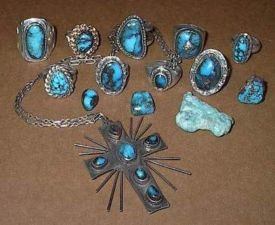
Bisbee Blue
Encyclopedia

Turquoise
Turquoise is an opaque, blue-to-green mineral that is a hydrous phosphate of copper and aluminium, with the chemical formula CuAl648·4. It is rare and valuable in finer grades and has been prized as a gem and ornamental stone for thousands of years owing to its unique hue...
that comes from copper
Copper
Copper is a chemical element with the symbol Cu and atomic number 29. It is a ductile metal with very high thermal and electrical conductivity. Pure copper is soft and malleable; an exposed surface has a reddish-orange tarnish...
mines located in the vicinity of Bisbee, Arizona
Bisbee, Arizona
Bisbee is a city in Cochise County, Arizona, United States, 82 miles southeast of Tucson. According to 2005 Census Bureau estimates, the population of the city was 6,177...
.
Though small amounts were found in the Campbell shaft mine, as well as in streambeds in the Mule Mountains
Mule Mountains
The Mule Mountains are a north/south running mountain range located in the south-central area of Cochise County, Arizona. The highest peak, Mount Ballard, rises to...
, the vast majority of Bisbee turquoise surfaced when the Phelps Dodge Corporation started open pit mining operations at the location now known as the Lavender Pit
Lavender Pit
The Lavender Pit is a former open pit copper mine near Bisbee in Cochise County, Arizona, United States. It is located near the famous Copper Queen Mine. The Lavender Pit was named in honor ofHarrison M...
, especially the eastern side of the pit. Large amounts of a conglomerate
Conglomerate (geology)
A conglomerate is a rock consisting of individual clasts within a finer-grained matrix that have become cemented together. Conglomerates are sedimentary rocks consisting of rounded fragments and are thus differentiated from breccias, which consist of angular clasts...
rock
Rock (geology)
In geology, rock or stone is a naturally occurring solid aggregate of minerals and/or mineraloids.The Earth's outer solid layer, the lithosphere, is made of rock. In general rocks are of three types, namely, igneous, sedimentary, and metamorphic...
bed needed to be removed before the copper
Copper
Copper is a chemical element with the symbol Cu and atomic number 29. It is a ductile metal with very high thermal and electrical conductivity. Pure copper is soft and malleable; an exposed surface has a reddish-orange tarnish...
ore
Ore
An ore is a type of rock that contains minerals with important elements including metals. The ores are extracted through mining; these are then refined to extract the valuable element....
located more deeply could be reached. This conglomerate "waste" rock was the host for most of the turquoise, both in vein and nugget form. Bisbee turquoise can be found in many different shades of color and quality, from soft, low quality pale blue to the quality hard brilliant blue turquoise and almost every shade of blue in between. Green turquoise is also found in Bisbee, but is not usually of very high quality.
The Turquoise from Bisbee, Arizona is most commonly known for its deep blue color and its brownish red matrix. The highest grade of Bisbee Blue Turquoise is almost lapis lazuli
Lapis lazuli
Lapis lazuli is a relatively rare semi-precious stone that has been prized since antiquity for its intense blue color....
blue and has a red spiderweb matrix. Most of this quality of stone is set into 14k and 18k gold jewelry by famous Southwestern jewelers.
During the time that the largest quantities of turquoise were being extracted from the mine, the company made no organized effort to recover it. It simply got loaded into large dump trucks and hauled off to the "dumps". During this time (primarily from the late 1950s to the late 1960s), some of the recovered turquoise was obtained by company employees taking it home in their lunch boxes, etc. Though this activity was prohibited, the prohibition was rarely enforced. For several years (mostly the early to late 1970s), these individuals, locally known as "dumpers", were the only source for this fine turquoise. During this time, Phelps Dodge leased out the dumps to Bob Matthews. Matthews was the only legal miner of the Bisbee Turquoise in history and was the major source for the turquoise. Matthews sold large lots to the famous artists the Zacharys from Albuquerque, New Mexico
Albuquerque, New Mexico
Albuquerque is the largest city in the state of New Mexico, United States. It is the county seat of Bernalillo County and is situated in the central part of the state, straddling the Rio Grande. The city population was 545,852 as of the 2010 Census and ranks as the 32nd-largest city in the U.S. As...
, the owners of the Turquoise Museum in Albuquerque, New Mexico, John Hartman in Durango, Colorado
Durango, Colorado
The City of Durango is a Home Rule Municipality that is the county seat and the most populous city of La Plata County, Colorado, United States. The United States Census Bureau said that the city population was 16,887 in 2010 census.-History:...
, and many other famous artists and traders. The majority of Matthews Bisbee was sent to Durango, Colorado to be made into jewelry by the Mickelson's Jewelry company. Cecil Mickelson was Bob Matthews Brother-in-law. The company made gorgeous Bisbee Blue and Villa Grove inlay Turquoise Jewelry up until the 1980s. In the early 2000s the Durango Silver Company (co-owner John Hartman) bought what was left of the Bob Matthews/Cecil Mickelson Collection of Bisbee Turquoise. This collection amounted to approximately 500 lb (226.8 kg) of rough Bisbee Turquoise. Today you can find the Turquoise in jewelry by Durango Silver Company.

